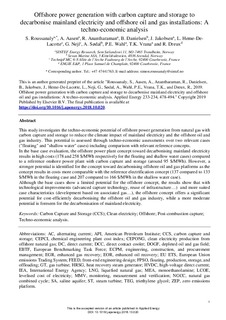| dc.contributor.author | Roussanaly, Simon | |
| dc.contributor.author | Aasen, Ailo | |
| dc.contributor.author | Anantharaman, Rahul | |
| dc.contributor.author | Danielsen, B. | |
| dc.contributor.author | Jakobsen, Jana Poplsteinova | |
| dc.contributor.author | Heme-De-Lacotte, L. | |
| dc.contributor.author | Neji, G. | |
| dc.contributor.author | Sødal, A. | |
| dc.contributor.author | Wahl, Per Eilif | |
| dc.contributor.author | Vrana, Til Kristian | |
| dc.contributor.author | Dreux, R. | |
| dc.date.accessioned | 2019-01-25T14:25:38Z | |
| dc.date.available | 2019-01-25T14:25:38Z | |
| dc.date.created | 2018-10-24T13:01:45Z | |
| dc.date.issued | 2018 | |
| dc.identifier.citation | Applied Energy. 2018, 233-234 478-494. | nb_NO |
| dc.identifier.issn | 0306-2619 | |
| dc.identifier.uri | http://hdl.handle.net/11250/2582427 | |
| dc.description.abstract | his study investigates the techno-economic potential of offshore power generation from natural gas with carbon capture and storage to reduce the climate impact of mainland electricity and the offshore oil and gas industry. This potential is assessed through techno-economic assessments over two relevant cases (“floating” and “shallow water” cases) including comparison with relevant reference concepts. In the base case evaluation, the offshore power plant concept toward decarbonising mainland electricity results in high costs (178 and 258 $/MWh respectively for the floating and shallow water cases) compared to a reference onshore power plant with carbon capture and storage (around 95 $/MWh). However, a stronger potential is identified for the concept toward decarbonising offshore oil and gas platforms as the concept results in costs more comparable with the reference electrification concept (137 compared to 133 $/MWh in the floating case and 207 compared to 166 $/MWh in the shallow water case). Although the base cases show a limited potential for the offshore concept, the results show that with technological improvements (advanced capture technology, reuse of infrastructure…) and more suited case characteristics (development based on associated gas…), the offshore concept offers a significant potential for cost-efficiently decarbonising the offshore oil and gas industry, while a more moderate potential is foreseen for the decarbonisation of mainland electricity. | nb_NO |
| dc.description.abstract | Offshore power generation with carbon capture and storage to decarbonise mainland electricity and offshore oil and gas installations: A techno-economic analysis | nb_NO |
| dc.language.iso | eng | nb_NO |
| dc.publisher | Elsevier | nb_NO |
| dc.rights | Attribution-NonCommercial-NoDerivatives 4.0 Internasjonal | * |
| dc.rights.uri | http://creativecommons.org/licenses/by-nc-nd/4.0/deed.no | * |
| dc.title | Offshore power generation with carbon capture and storage to decarbonise mainland electricity and offshore oil and gas installations: A techno-economic analysis | nb_NO |
| dc.type | Journal article | nb_NO |
| dc.type | Peer reviewed | nb_NO |
| dc.description.version | acceptedVersion | nb_NO |
| dc.source.pagenumber | 478-494 | nb_NO |
| dc.source.volume | 233-234 | nb_NO |
| dc.source.journal | Applied Energy | nb_NO |
| dc.identifier.doi | 10.1016/j.apenergy.2018.10.020 | |
| dc.identifier.cristin | 1623083 | |
| dc.relation.project | Norges forskningsråd: 616062 | nb_NO |
| dc.relation.project | Norges forskningsråd: 248266 | nb_NO |
| cristin.unitcode | 7548,60,0,0 | |
| cristin.unitcode | 7548,50,0,0 | |
| cristin.unitname | Gassteknologi | |
| cristin.unitname | Energisystemer | |
| cristin.ispublished | true | |
| cristin.fulltext | postprint | |
| cristin.qualitycode | 1 | |

